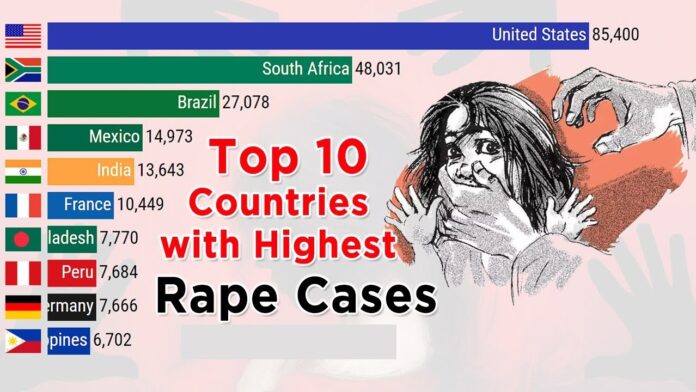In today’s rapidly changing world, understanding social and cultural issues is crucial to fostering a safer and more inclusive global society. One such issue that demands our attention is the reported rape rates per 100,000 inhabitants across different countries. This article delves into the statistics, highlights some startling numbers, and explores potential factors contributing to these rates. By shedding light on this sensitive topic, we aim to raise awareness and encourage meaningful conversations that could lead to positive change.
Unveiling the Disturbing Numbers
The reported rape rates per 100,000 inhabitants vary significantly from one country to another. Here are the top 10 countries with the highest reported rape rates:
- Botswana – 92.93
- Lesotho – 82.68
- South Africa – 72.10
- Bermuda – 67.29
- Sweden – 63.54
- Suriname – 45.21
- Costa Rica – 36.70
- Nicaragua – 31.60
- Grenada – 30.63
- Saint Kitts And Nevis – 28.62
It’s alarming to see these numbers, and they shed light on a critical issue that requires urgent attention. However, it’s important to note that these statistics only provide a snapshot of the situation and don’t fully capture the complex factors at play.
Delving Deeper: Possible Influencing Factors
The reported rape rates are influenced by a multitude of factors, including social, cultural, economic, and legal variables. While we can’t cover every nuance, let’s explore a few potential factors that might contribute to these rates:
1. Cultural Norms and Gender Equality
Cultural norms surrounding gender roles and expectations can significantly impact the prevalence of sexual violence. Societies that promote gender equality and challenge traditional stereotypes tend to have lower reported rape rates. Initiatives that educate and raise awareness about consent and respect can help shift these norms.
2. Economic Disparities
Economic inequalities can create an environment where some individuals are more vulnerable to sexual violence. Lack of access to education, healthcare, and stable employment can exacerbate power imbalances and increase the risk of exploitation.
3. Legal Framework and Reporting Mechanisms
The effectiveness of a country’s legal system and reporting mechanisms also plays a crucial role. Countries with strong legal frameworks for addressing sexual violence, providing support to survivors, and prosecuting perpetrators tend to have lower reported rape rates.
4. Social Support and Mental Health Services
Accessible mental health services and support for survivors are essential in addressing the aftermath of sexual violence. Countries that prioritize these services can empower survivors to seek help and healing.
Progress and Hope for Change
While the statistics may seem disheartening, it’s essential to acknowledge the efforts being made to address sexual violence globally. Organizations, activists, and governments are working together to raise awareness, provide support, and enact legal reforms that can lead to positive change.
A Call to Action
The reported rape rates per 100,000 inhabitants highlight a distressing reality that cannot be ignored. By understanding the contributing factors and engaging in meaningful discussions, we can collectively work towards creating safer societies for everyone. It’s imperative that we continue to support survivors, challenge harmful norms, and advocate for policies that promote gender equality and justice.
Remember, the numbers only tell part of the story. Behind each statistic is a human experience, and it’s our responsibility to listen, learn, and take action.
As we move forward, let’s strive for a world where the reported rape rates are not just statistics, but a reminder of the progress we’ve made and the work that still lies ahead.


